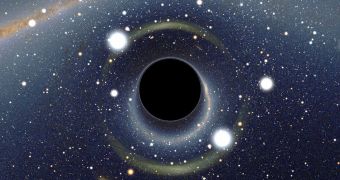New wormhole research would seem to indicate that our entire Universe may in fact be located within an Einstein-Rosen Bridge, a structure more commonly referred to as a wormhole. This region of space may itself be located inside a black hole, in a much larger Universe than we could ever hope to imagine. The new idea belongs to expert Nikodem Poplawski, who is a theoretical physicist at the Indiana University, in the United States. Details of his proposal will appear in the April 12 print issue of the esteemed scientific publication Physical Letters B, and are already available online.
The physicist bases his hypothesis on some fairly advanced calculations. He describes in the journal entry that he used isotropic coordinates for the job. These are components of a Euclidean-based coordinate system, which he uses to describe the gravitational field that a black hole produces around it. Derived from this, the expert calculates the radial geodesic motion that a massive particle may have inside a black hole. Poplawski paid special attention in his work to what happens when this hypothesized particle passes through the event horizon, or what is known as the boundary, of the hole.
Albert Einstein's theory of general relativity allows for the existence of two distinct types of black holes, the Schwarzschild and Einstein-Rosen. Both of them are mathematical solutions extracted directly from the theory. The issue with studying particles inside black holes is that it's impossible. Outside observers can only view the exterior parts of the dark behemoths, and the physicist says that, in order for the motion of a particle falling through the event horizon to be accurately analyzed, one would need to be situated past the boundary as well. This is, however, impossible with current technology, and will most likely stay that way for centuries to come.
“This condition would be satisfied if our Universe were the interior of a black hole existing in a bigger Universe. Because Einstein's general theory of relativity does not choose a time orientation, if a black hole can form from the gravitational collapse of matter through an event horizon in the future then the reverse process is also possible. Such a process would describe an exploding white hole: matter emerging from an event horizon in the past, like the expanding Universe,” the expert explains. Another idea in the paper is that all black holes, regardless of type, may have Einstein-Rosen bridges inside, which means that their formation may be accompanied by the birth of another Universe within.
“From that it follows that our Universe could have itself formed from inside a black hole existing inside another Universe,” he notes further. This new idea could explain a host of difficulties that astrophysicists have in reconciling the Big Bang model, and the inflation theory, with the actual observations conducted via satellites and telescopes. It may be that Poplawski's idea actually explains the origins of inflation, the theory seeking to show why the Universe expands at its current rate, PhysOrg reports.

 14 DAY TRIAL //
14 DAY TRIAL //